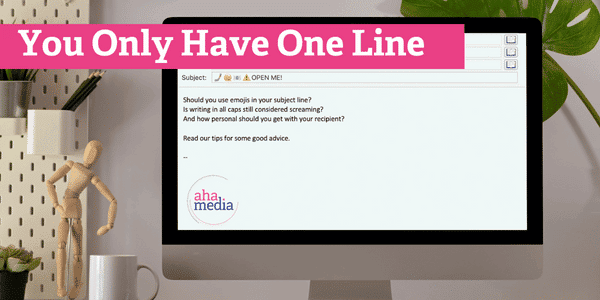
Many of us spend time crafting the perfect email but then just dash off a subject line almost as an afterthought. We’re here to tell you: Stop. That subject line may be the most important part of your email. Why? Because even the most articulate message won’t ever get read if your recipient doesn’t bother opening the email.
But why does email matter when you’re also using all the latest, buzziest social media marketing and ad platforms? Because email is the best-performing marketing channel you have.
Yes, it beats social media, video and display ads for return on investment.
And what’s going to get your recipient to click on your message? The subject line. It’s your digital make-it-or-break-it moment. Those few well-chosen characters will determine if your recipient opens you or deletes you forever.
7 Tips for Writing a Great Email Subject Line
So, how can you increase your chances of a reader clicking on that email?
We’ll start with the bottom line: Use many of the same best web writing practices for your subject line that you use for web content. Because essentially, an email subject line is web content, just in a sparse, stripped-down form.
But keep an eye on emerging trends. Some things you think are absolute don’ts might be myths or dated advice. Read on for the basics:
Keep it short
40-50 characters are the max, and seven words hit the sweet spot. But keep in mind that on mobile devices, readers may see only half that. So make sure you frontload the subject line with the important information. “HealthWalk: This Sunday! With [Your Organization Name Here]” covers the “what and when” in just the first 25 characters.
Think of it this way: Words are money, and you’re stingy—spend them sparingly and only for the really important things.
Respect your readers
Do you personalize a subject line with the recipient’s name? Will the word “free” automatically land your email in the spam folder? How do you avoid a clickbait-y subject line?
First and best advice: Be honest and direct about what your email holds inside. Don’t promise something you don’t deliver — it annoys your audience and shows no respect.
But this doesn’t mean certain words are off-limits. If “Free offer for James” is accurate, then it’s not clickbait. And there are no specific words that automatically send an email to spam. That advice is dated.
And as for James? Some studies show that he’s more likely to click an email with a personalized subject line. So give it a try and see what works for your audience.
Words in a subject line don’t send an email to Spam. Watch Jay Schwedelson explain more in the first 5 minutes of this video:
Use emojis, all caps and exclamation points — sparingly
Some of you might be clinging to advice never to use silly emojis. Or believe that capitalization always indicates screaming. And that exclamation marks need to be avoided at all costs.
Well, never say never. It’s OK and might even improve your open rate if you use one well-chosen emoji. A single exclamation point can sometimes prompt a click. And one or two all-caps words can get attention if they’re the most meaningful to your audience.
The key is intentionality and restraint, with a dash of experimentation.
Indicate time sensitivity
If your email is time sensitive, mention that in the subject line. Some examples: “Response needed by EOD 6/14,” “Mark your calendar — marketing webinar 2/25” or “Register today to reserve your spot.” In other words, nix the flowery intro and just cut to the chase.
Edit
Check for spelling and grammar errors or cut and paste errors just as you would in your email. Your subject line is your first impression on your readers. Make sure it’s professional, not sloppy.
Emphasize relevant information
Just like good web content opens up a conversation with your readers, so should your subject line. If you’re emailing a newsletter, the subject line should include an interesting snippet from an article, not “May 2014 Newsletter.” If it’s an announcement, event or an activity from a local organization, include the relevant details in the subject line, not just the organization’s name.
Subject lines for sales and marketing campaigns also need specifics. Don’t just say, “New service announced at Our Company” or “Save money at Big Name Organization.” Consider who your audience is, what they want and how you can help them. Then incorporate key words and phrases describing those things into your subject line.
Test and test some more
A lot of the advice above relies on knowing what your audience wants and what they respond to. But how do you know?
Email marketing is much more sophisticated than 10 or even five years ago. Start now if you haven’t explored tools to help you measure your email’s success. It’s especially useful to A/B test two different versions of your subject lines. It can help you see whether tactics like emojis, varied punctuation, specific phrasing, content format and personalization make a marked difference in audience engagement.
You might already have this functionality in the email program you use for your mailing lists. Or, you might want to explore newer or more intricate testing tools to get more granular insights.
Need more evidence that testing is the answer? Watch this 90-second video clip:
It may seem daunting—how can you make your email stand out among the dozens or even hundreds of emails your readers receive every day? But with a little planning and consideration, you can craft a perfect subject line that is just begging (respectfully, of course) to be opened.
To find out even more about email marketing, check out our advice in Rethinking Your Email Marketing: A Quick Guide to Success.





